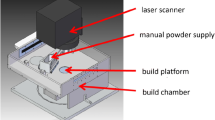Abstract
One of the most important factors for energy efficiency is the reduction of friction in machine elements. The grinding process is often the final machining process in machining hardened steel parts and the resulting surface finish influences the tribological behavior. The combination of grinding with a honing process can generate a plateau-like surface to reduce friction and create an oil reservoir to decrease abrasive wear and improve the fluid film stability. Additional processes like laser machining, micro milling or etching are able to generate micro dimples to improve the reduction of friction. Today, grinding processes are limited to machine plateau-like surfaces. Within this paper, a new tool concept will be presented, composed of a grinding tool with two different grain sizes and a metallic bonding. The use of small abrasive grains generates a smooth surface with low roughness values. A few additional larger grains induce stochastic scratches and create the plateau-like surface. Grinding experiments are conducted to analyze the effect of feed rate, feed angle and ratio between small and large grains on the resulting surface.






Similar content being viewed by others
References
Gless M (2010) Waelzkontaktermuedung bei Mischreibung. Dr.-Ing. Dissertation, Otto-von-Guericke-Universitaet Magdeburg
Tomanik E (2008) Friction and wear bench tests of different engine liner surface finishes. Tribol Int 41(11):102–108
Grabon W, Koszela W, Pawlus P, Achwat S (2013) Improving tribological behaviour of piston ring–cylinder liner frictional pair by liner surface texturing. Tribol Int 61:102–108
Denkena B, de Leon L, van der Meer M, Turger A (2009) Flexible polishing with bounded grains for complex ceramic endoprostheses. In: Proceedings of the 24th ASPE annual meeting, USA
Malberg MC, Whitehouse DJ (1993) Characterization of surface texture generated by plateau honing process. Ann CIRP 42(1):637–639
Kaestner J (2013) Methode zur spanenden Herstellung reibungsoptimierender Mikroschmiertaschen. Dr.-Ing. Dissertation, Leibniz Universitaet Hannover
Wakuda M, Yamauchi Y, Kanzaki S, Yasuda Y (2003) Effect of surface texturing on friction reduction between ceramic and steel materials und lubricated sliding contact. Wear 254:356–363
Denkena B, Köhler J, Kästner J, Göttsching T, Dinkelacker F, Ulmer H (2013) Efficient machining of microdimples for friction reduction. J Micro Nano Manuf 1(1):011003–011008-8. doi:10.1115/1.4023757
Flores F (2010) Innovative Honverfahren. Motorenbau. VDI Z. Springer 152:28–31
Denkena B, Grove T, Bremer I, Behrens L (2016) Design of bronze-bonded grinding wheel properties. CIRP Ann Manuf Technol 65(1):333–336
Hecker RL, Liang SY (2003) Predictive modeling of surface roughness in grinding. Int J Mach Tools Manuf 43(8):755–761
Aurich JC, Biermann D, Blum H, Brecher C, Carstensen C, Denkena B, Klocke F, Kroeger M, Steinmann P, Weinert K (2009) Modelling and simulation of process: machine interaction in grinding. Prod Eng Res Dev 3:111–120
Toenshoff HK, Peters J, Inasaki T, Paul T (1992) Modelling and simulation of grinding processes. CIRP Ann Manuf Technol 41(2):677–688
Behrens L (2016) Schleifen von PCBN. Dr.-Ing. Disseration, Leibniz Universitaet Hannover
Kannappan S, Malkin S (1972) Effects of gran size and operating parameters on the mechanics of grinding. J Eng Ind 8:833–842
Denkena B, Koehler J, Kaestner J (2012) Chip formation in grinding: an experimental study. Prod Eng Res Dev 6:107–115
Lierse T (1998) Mechanische und thermische Wirkung beim Schleifen keramischer Werkstoffe. Dr.-Ing. Dissertation, Universitaet Hannover
Uhlmann E, Klein TB, Hochschild L, Baecker C (2011) Influence of structuring by abrasive machining on the tribological properties of workpiece surfaces. Procedia Eng 19:363–370
Uhlmann E, Baecker C, Schroeder N (2013) Surface structuring using kinematic modulation in grinding. Prod Eng Res Dev 7:373–381
Acknowledgements
The authors thank the German Research Foundation (DFG) for founding this work within the collaborative research “Resource Efficient Machine Elements” (SPP1551) and the support of the Federal Ministry of Economics and Technology (BMWi) based on a resolution of the German Federal Parliament by funding the Project “Development of a new tool- and dressing concept customized to the profile grinding of involute toothings with metal bond CBN-tools” (KF2328126AT4).
Author information
Authors and Affiliations
Corresponding author
Rights and permissions
About this article
Cite this article
Denkena, B., Grove, T., Maiss, O. et al. New tool concept for grinding a plateau-like surface for tribological applications. Prod. Eng. Res. Devel. 11, 419–424 (2017). https://doi.org/10.1007/s11740-017-0758-z
Received:
Accepted:
Published:
Issue Date:
DOI: https://doi.org/10.1007/s11740-017-0758-z




